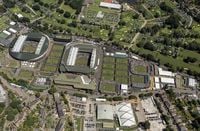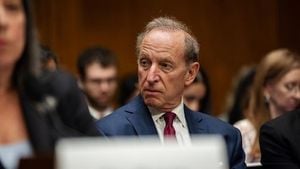Wimbledon’s ambitious plan to nearly triple the size of its tournament grounds has cleared a significant legal hurdle after a High Court judge dismissed a challenge from the campaign group Save Wimbledon Park (SWP). The ruling, delivered on Monday, July 21, 2025, by Mr Justice Saini, upheld the Greater London Authority’s (GLA) decision to grant planning permission for the expansion, which includes the construction of 38 new tennis courts and an 8,000-seat stadium on the grounds of the former Wimbledon Park Golf Club.
The All England Lawn Tennis Club (AELTC), the body behind Wimbledon, aims to bring its qualifying rounds on-site for the first time, ending the tournament’s unique status as the only Grand Slam that holds qualifiers separately. The proposed development also features seven maintenance buildings, multiple access points, and a newly accessible 27-acre area of parkland, including enhancements to Wimbledon Lake with a boardwalk, all designed to boost the tournament’s capacity and community engagement.
The legal challenge was mounted by SWP, which argued that the land, a Grade II*-listed heritage site partly designed by famed landscape architect Lancelot “Capability” Brown, is subject to restrictive covenants and a statutory trust requiring it to remain available for public recreation. The campaigners contended that the GLA’s approval was “irrational” and violated these protections, emphasizing the importance of preserving open green spaces amid London’s urban sprawl.
However, in his decisive ruling, Justice Saini concluded that the GLA’s decision was a “planning judgment rationally exercised and having regard to appropriate and relevant factors.” He noted that the alleged statutory trust and restrictive covenants were considered but deemed “not material” to the planning permission granted. This judgment effectively allows the All England Club to proceed with its £200 million expansion project.
Debbie Jevans, chair of the AELTC, welcomed the ruling, stating, “We are delighted that Mr Justice Saini has dismissed the challenge to the GLA’s decision to grant planning permission for our plans to transform the former Wimbledon Park golf course.” She highlighted that the club had engaged with more than 10,000 people to explain the plans and that the majority supported moving forward. “It is clear that we have a robust planning permission that enables us to create a permanent home for the Wimbledon qualifying competition as well as delivering 27 acres of beautiful new parkland for local people, providing public access to land that has been a private golf course for over 100 years,” Jevans added.
The expansion aims to bring Wimbledon in line with the other Grand Slams — the Australian Open, French Open, and US Open — which already host their qualifying events on-site. Jevans explained earlier this year that the transformation was vital to integrate three-week events, accommodate more spectators, and enhance facilities for players, many of whom currently share limited practice courts during the tournament.
Opponents of the plan remain vocal, with hundreds gathering outside the Royal Courts of Justice during the hearing in early July to protest what they see as an overreach into protected green belt and public open spaces. Christopher Coombe, director of SWP, warned that the judgment could set a “worrying precedent” for developments on protected lands across London and the UK. He urged the AELTC to engage constructively to resolve the dispute, emphasizing the land’s historic covenant restricting use “other than for leisure or recreational purposes or as an open space.”
Indeed, the legal battle is not over. A separate hearing is scheduled for January 2026 to determine whether a statutory trust exists over the former golf course land, a question that could impact the future of the development. The AELTC has accepted that if such a trust exists, it may conflict with the proposed plans, but the club disputes the trust’s existence and is seeking clarity through the courts.
Mayor of London Sadiq Khan, who recused himself from the planning decision due to prior public support for the project, welcomed the High Court’s ruling. He described the scheme as one that would bring “significant economic, social, cultural, and environmental benefits” to the local area, London, and the UK economy, including job creation and the addition of green spaces.
Jules Pipe, London’s deputy mayor for planning, who granted the planning permission in September 2024, had earlier emphasized the “very significant benefits” of the proposals, stating they “clearly outweigh the harm.” The project’s estimated £200 million cost reflects its scale and ambition, aiming to secure Wimbledon’s status as the world’s premier tennis competition and London’s reputation as a global sporting capital.
The All England Club’s acquisition history adds context to the dispute. The club purchased the Wimbledon Park golf course land from Merton Council in 1993 for £5.2 million and later acquired the golf club’s leasehold in 2018 for £65 million, a transaction that resulted in compensation payments to members. The land has been a private golf course for over a century, and the club’s plans to open 27 acres of parkland to the public represent a significant shift in access.
While the High Court ruling marks a major victory for Wimbledon’s expansion, the club acknowledges that construction and completion will take time, with new courts unlikely to be ready until the 2030s. Meanwhile, the ongoing legal proceedings concerning the statutory trust will be closely watched by both supporters and opponents, as they could influence the project’s ultimate fate.
Wimbledon’s expansion reflects broader tensions between urban development, heritage preservation, and public access to green spaces. As the All England Club pushes forward with its vision, the balance between sporting excellence and community interests remains a delicate and contested issue.




